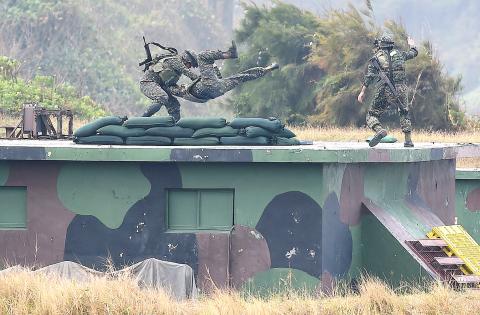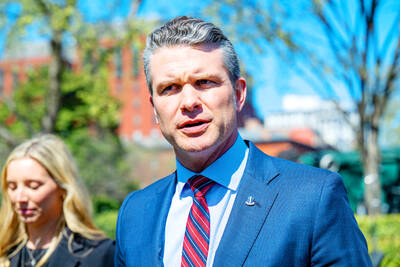The Republic of China Marine Corps conducted a combat exercise in the Kaohsiung Harbor area yesterday, with the main objective being to train troops to defend against a simulated surprise attack on the southern port city by the Chinese People’s Liberation Army (PLA).
The 99th Marine Brigade’s Third Battalion, stationed at Kaohsiung’s Zuoying Naval Base, took the lead role in the military exercises.
A live-fire drill simulated a PLA surprise attack and seizure of the harbor, where a 30-man unit hid in a Chinese cargo ship entering Kaohsiung port to dock.

Photo: Liao Chen-hui, Taipei Times
The scenario had the simulated PLA military unit emerge from the ship to assault the dock and kill security staff, going on to seize the harbor’s administrative buildings and other facilities.
The 99th Marine Brigade was supported by other armored infantry and amphibious fighting units as it went into action, with quick operations and engagement to overpower the enemy force, completing their mission to retake the facilities.
Amphibious assault vehicles and a locally developed anti-tank rocket system were also deployed in the drill.
A Marine Corps sniper squad also participated in the drills, deploying for the counterattack to retake the occupied buildings.
The snipers demonstrated their capabilities by hitting targets from a distance of about 250m, earning praise from naval officials in attendance.
Before every Lunar New Year, the military organizes media tours of some military units to showcase their preparedness to protect the country from potential attacks during the holiday season.
The army and air force held similar drills on Tuesday to demonstrate their combat readiness.

‘DENIAL DEFENSE’: The US would increase its military presence with uncrewed ships, and submarines, while boosting defense in the Indo-Pacific, a Pete Hegseth memo said The US is reorienting its military strategy to focus primarily on deterring a potential Chinese invasion of Taiwan, a memo signed by US Secretary of Defense Pete Hegseth showed. The memo also called on Taiwan to increase its defense spending. The document, known as the “Interim National Defense Strategic Guidance,” was distributed this month and detailed the national defense plans of US President Donald Trump’s administration, an article in the Washington Post said on Saturday. It outlines how the US can prepare for a potential war with China and defend itself from threats in the “near abroad,” including Greenland and the Panama

A magnitude 4.9 earthquake struck off Tainan at 11:47am today, the Central Weather Administration (CWA) said. The hypocenter was 32.3km northeast of Tainan City Hall at a depth of 7.3km, CWA data showed. The intensity of the quake, which gauges the actual effect of a seismic event, measured 4 in Tainan and Chiayi County on Taiwan's seven-tier intensity scale, the data showed. The quake had an intensity of 3 in Chiayi City and County, and Yunlin County, while it was measured as 2 in Kaohsiung, Nantou County, Changhua County, Taitung County and offshore Penghu County, the data showed. There were no immediate reports of

The Chinese Nationalist Party (KMT) is maintaining close ties with Beijing, the Democratic Progressive Party (DPP) said yesterday, hours after a new round of Chinese military drills in the Taiwan Strait began. Political parties in a democracy have a responsibility to be loyal to the nation and defend its sovereignty, DPP spokesman Justin Wu (吳崢) told a news conference in Taipei. His comments came hours after Beijing announced via Chinese state media that the Chinese People’s Liberation Army’s Eastern Theater Command was holding large-scale drills simulating a multi-pronged attack on Taiwan. Contrary to the KMT’s claims that it is staunchly anti-communist, KMT Deputy

RESPONSE: The government would investigate incidents of Taiwanese entertainers in China promoting CCP propaganda online in contravention of the law, the source said Taiwanese entertainers living in China who are found to have contravened cross-strait regulations or collaborated with the Chinese Communist Party (CCP) could be subject to fines, a source said on Sunday. Several Taiwanese entertainers have posted on the social media platform Sina Weibo saying that Taiwan “must be returned” to China, and sharing news articles from Chinese state media. In response, the Mainland Affairs Council (MAC) has asked the Ministry of Culture to investigate whether the entertainers had contravened any laws, and asked for them to be questioned upon their return to Taiwan, an official familiar with the matter said. To curb repeated